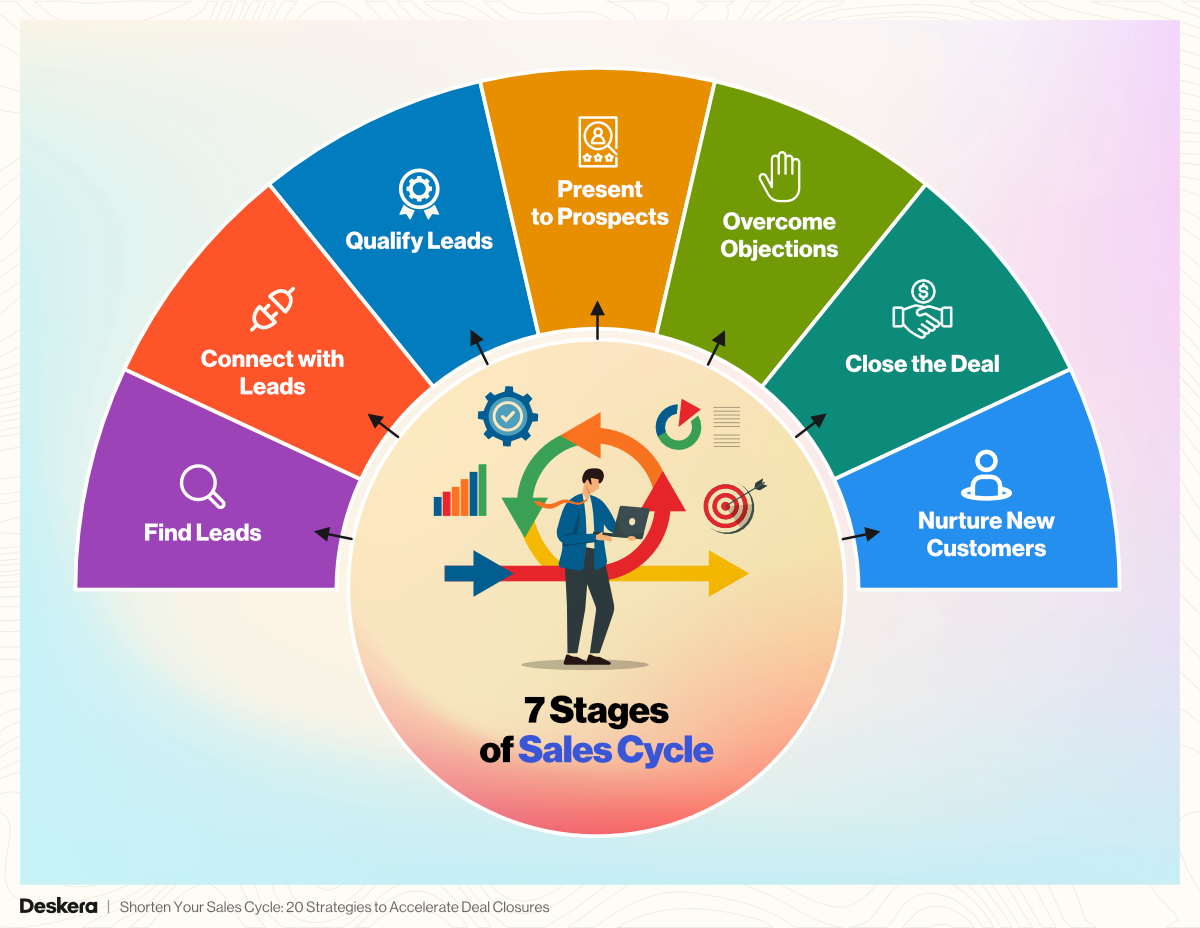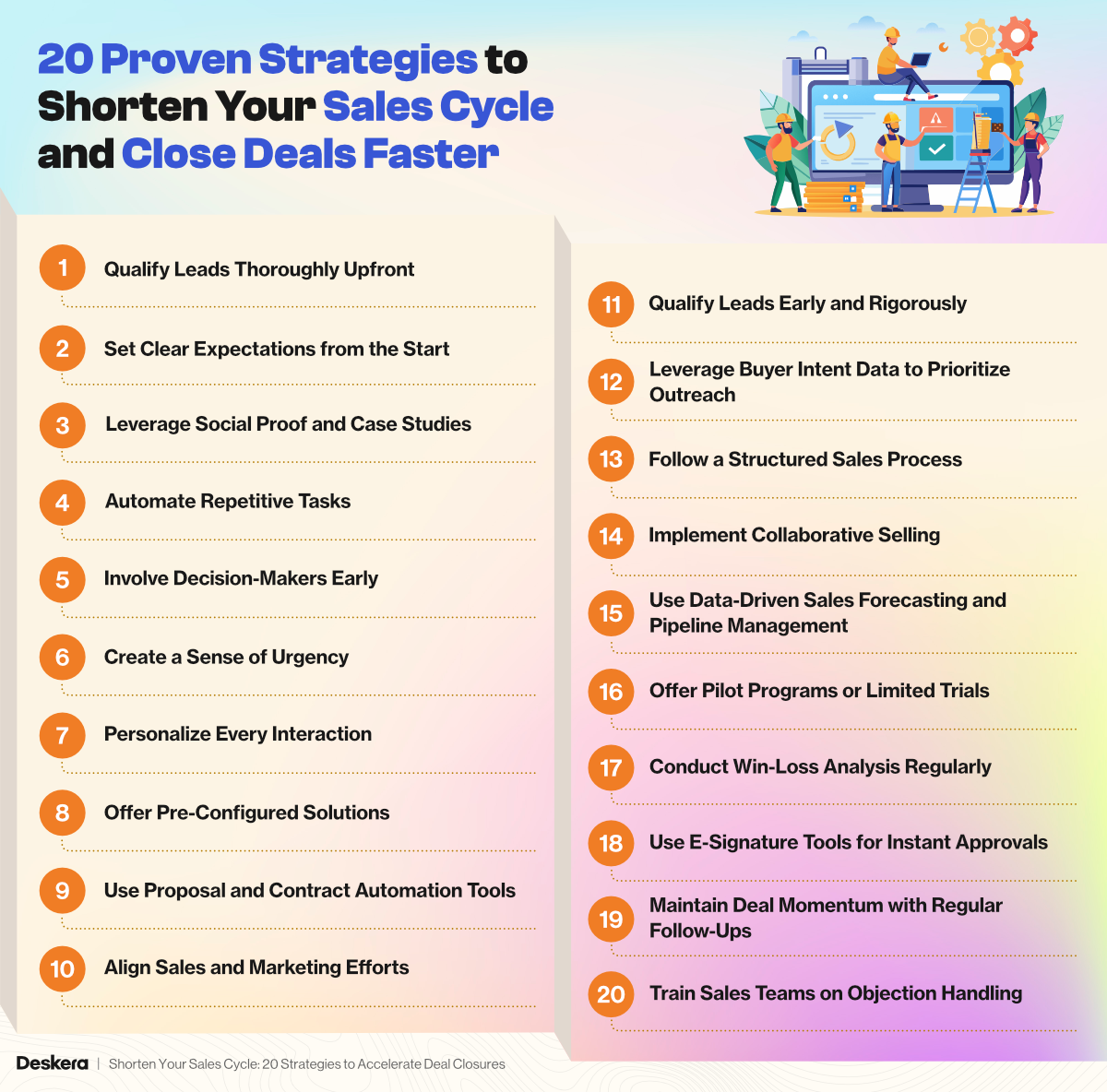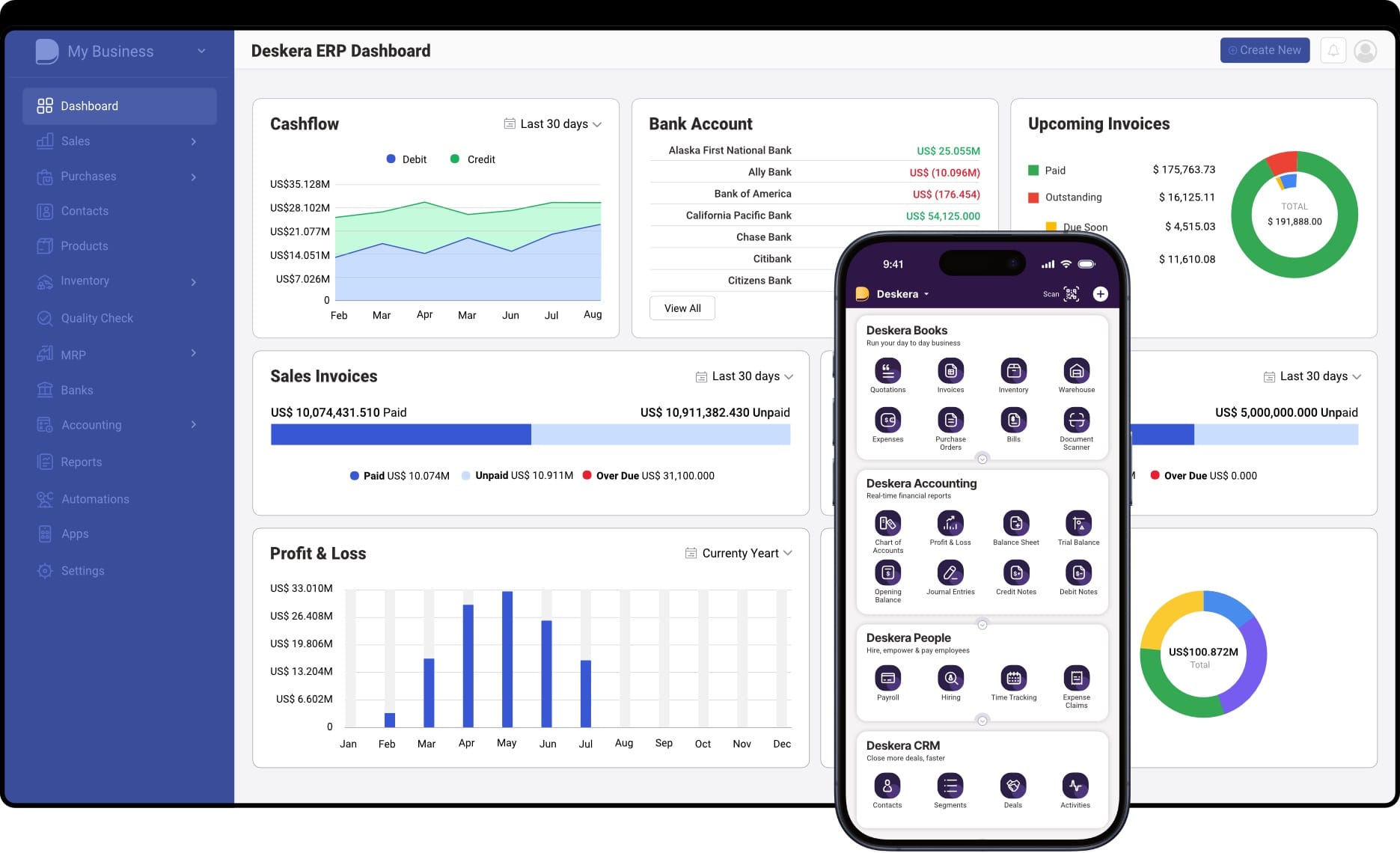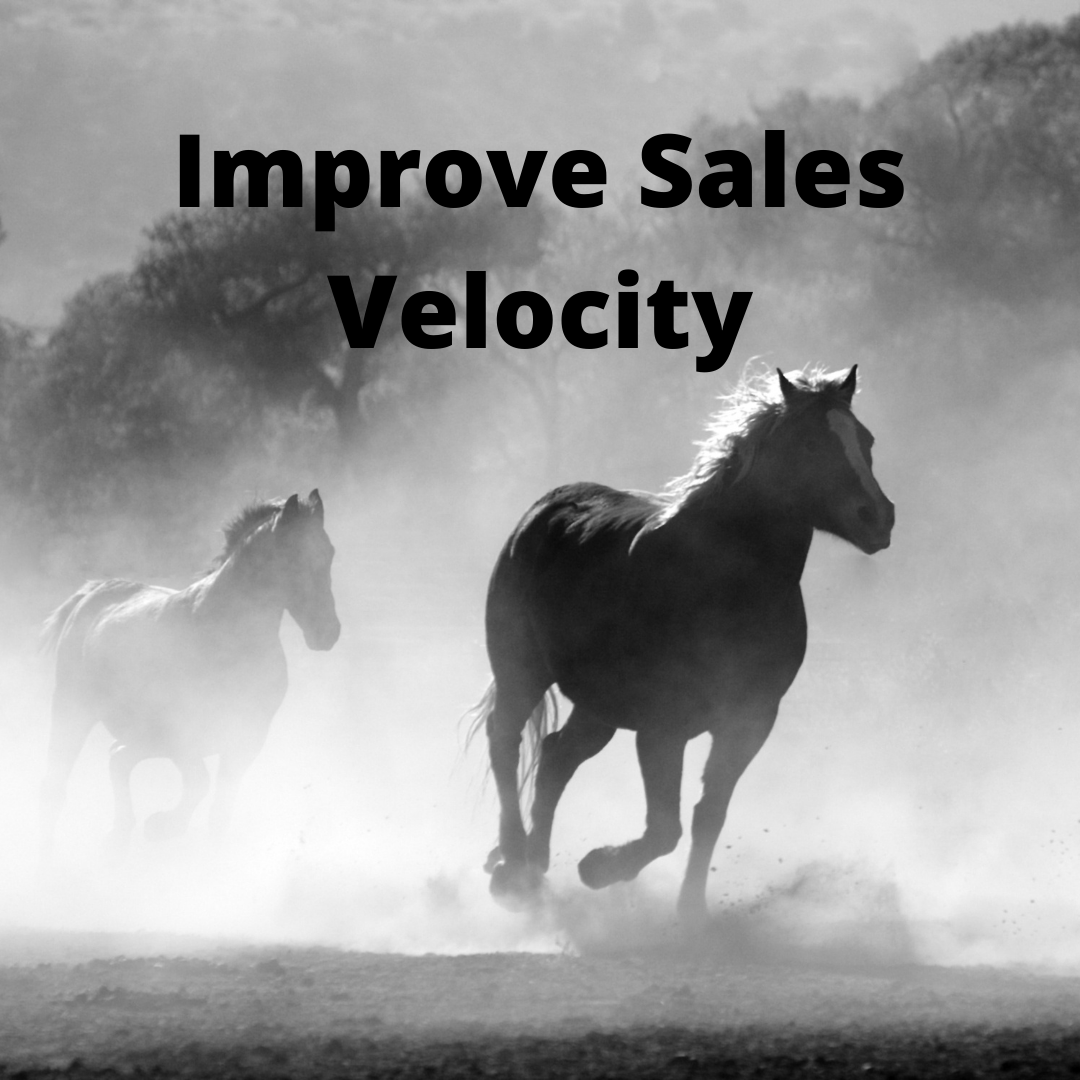In today’s hyper-competitive business landscape, time is more than just money—it’s momentum. A lengthy sales cycle can drain resources, frustrate sales teams, and cause even the most promising deals to go cold. The faster your business can move prospects through the funnel, the quicker you can generate revenue and outpace your competition. But for many sales teams, shortening the sales cycle remains a persistent challenge.
According to HubSpot, the average sales close rate hovers around 20%, although this figure can vary widely depending on the industry. This means that for every 10 leads you pursue, only two are likely to convert into customers. When combined with a drawn-out sales process, these odds become even more difficult to beat. Speeding up the sales cycle not only improves conversion rates but also boosts your team’s efficiency and morale.
The good news? You don’t have to overhaul your entire strategy to see results. With the right tactics—from better lead qualification to sales automation tools—you can trim unnecessary steps, improve engagement, and close deals faster. This blog dives into 20 proven strategies to help you do exactly that, whether you're managing a small team or overseeing a large B2B operation.
One powerful way to support a faster, more efficient sales process is through technology. Deskera ERP offers an all-in-one platform that integrates your sales, CRM, inventory, and finance operations—helping teams streamline workflows and reduce delays. With real-time insights, automation features, and mobile accessibility, Deskera empowers businesses to move smarter and sell faster.
What Is a Sales Cycle?
A sales cycle is the step-by-step, repeatable process that sales teams follow to turn potential leads into paying customers. It offers structure and predictability to the selling process, allowing salespeople to know exactly what to do next at every stage of the buyer’s journey. By following a defined sales cycle, teams can consistently replicate successful behaviors, track performance, and identify areas for improvement.
While sales cycles can vary slightly depending on the company, product, or industry, most follow a similar flow. The classic sales cycle includes seven key stages:

1. Find Leads
This is the prospecting phase where sales reps identify potential customers who may benefit from their product or service. The goal is to build a quality list of leads that match your ideal buyer profile. You can generate leads through various channels such as cold outreach, social media engagement, website forms, referrals, or even by answering questions on platforms like Quora or LinkedIn.
Why it matters: The quality of your leads sets the foundation for the rest of the sales cycle. Better leads mean higher chances of closing deals quickly.
2. Connect with Leads
Once you've identified potential leads, the next step is to initiate contact—usually through personalized emails, phone calls, or LinkedIn messages. This is not the time for a hard pitch. Instead, focus on building trust and offering value. Share helpful resources, insights, or case studies that address the lead’s pain points.
Pro tip: Research the lead beforehand and tailor your message. A thoughtful approach helps you stand out and increases the likelihood of a response.
3. Qualify Leads
Not every lead is a good fit. The goal of this stage is to determine whether the lead has the interest, need, authority, and budget to make a purchase. This is often done using a qualification framework like BANT (Budget, Authority, Need, Timeline) or CHAMP (Challenges, Authority, Money, Prioritization).
Key questions to ask:
- Does the lead recognize their need?
- Are they the decision-maker?
- Can they afford your solution?
Skipping this step can result in wasted time and resources chasing unqualified leads.
4. Present to Prospects
At this stage, your lead becomes a qualified prospect, and it's time to demonstrate how your product or service solves their problems. This is usually done through a sales presentation, product demo, or proposal. The presentation should focus on benefits (not just features) and be supported by relevant data, case studies, or customer success stories.
Effective presentations:
- Begin with a quick recap of their challenges
- Show how your solution helps
- End with a clear path forward
5. Overcome Objections
Even with a great pitch, most prospects will have concerns or hesitations. These could relate to pricing, competitors, timing, or internal constraints. Addressing objections effectively requires active listening, empathy, and a well-prepared value proposition.
Common objections and responses:
- “It’s too expensive” → Emphasize long-term ROI
- “We’re using a competitor” → Highlight unique differentiators
- “Not now” → Revisit their timeline and reinforce urgency
6. Close the Deal
You’ve built trust, demonstrated value, and addressed concerns—now it’s time to close. There are several techniques to use here, such as the assumptive close (acting as if the sale is a done deal), the suggestion close (recommending the best option), or the urgency close (using a limited-time offer).
Best practices:
- Keep your proposal clear and easy to sign
- Summarize agreed terms
- Follow up promptly if they need more time
If the deal doesn’t close, ask for feedback and nurture the lead for future opportunities.
7. Nurture New Customers
Closing the deal isn’t the end—it’s the beginning of a long-term relationship. A solid onboarding process, regular check-ins, and ongoing support can turn a new customer into a loyal advocate. Share helpful resources, offer training, and stay engaged.
Why it matters: Happy customers are more likely to renew, upgrade, or refer others—reducing future sales cycles and increasing lifetime value.
Each stage plays a critical role in building trust, delivering value, and guiding prospects toward a confident purchasing decision. For example, early stages focus on identifying and understanding the customer’s pain points, while later steps involve solution presentations, addressing objections, and finalizing contracts.
A well-executed sales cycle not only helps close deals faster but also improves customer experience, boosts conversion rates, and provides clarity on where each lead stands in your pipeline.
When combined with the right tools and analytics—such as those found in integrated platforms like Deskera ERP—sales teams gain deeper insights, automate repetitive tasks, and accelerate the journey from first contact to closed deal.
What Causes a Long Sales Cycle?
A long sales cycle is typically the result of increased deal complexity, multiple decision-makers, and organizational processes that require more time and scrutiny. While some businesses can close deals in days or weeks, others may face months—or even a year—of negotiation and evaluation.
Below are the most common factors that contribute to an extended sales cycle:
1. Multiple Stakeholder Approvals
Enterprise deals rarely involve a single decision-maker. Sales reps must often navigate approval chains that include IT, finance, procurement, legal, and executive teams. The more people involved, the longer it takes to build consensus and secure sign-off.
2. Extensive Evaluation and Vetting Processes
High-value or business-critical purchases usually undergo rigorous due diligence. Buyers want to ensure that the product or service fits their operational needs, integrates with existing systems, and meets all functional and compliance requirements. This often includes trials, demos, and pilot programs.
3. Complex Contract Negotiations
For large deals, contracts often require detailed terms that cover legal, financial, and operational concerns. Legal teams may review and negotiate every clause, leading to lengthy back-and-forth discussions before a final agreement is reached.
4. Procurement and Budgeting Cycles
Many organizations follow structured procurement procedures and fixed budgeting timelines. Even if a deal is desirable, it may need to wait for a new fiscal period or pass through several rounds of internal budget reviews.
5. Bureaucratic Red Tape
Larger companies tend to have more layers of bureaucracy, which can delay approvals and slow down communication. Each internal department might require its own set of documentation, meetings, or risk assessments.
6. Change Management Planning
Implementing a new solution—especially one that affects multiple departments—requires careful planning and coordination. Internal teams may need time to prepare for organizational change, train staff, and mitigate disruption to existing workflows.
7. High Costs and High Stakes
The higher the cost and impact of the solution, the more cautious buyers become. Enterprises are naturally more thorough when large budgets, strategic goals, and business continuity are at stake. This leads to deeper due diligence and longer deliberation periods.
8. Existing Vendor Relationships
If a potential customer is already working with an incumbent vendor, switching may require extensive internal justification. Sales reps may need to respond to RFPs, provide side-by-side comparisons, and demonstrate significant value over the current solution.
9. Security and Compliance Reviews
Today’s buyers are especially vigilant about data privacy, cybersecurity, and regulatory compliance. Enterprise solutions often face rigorous security assessments before being approved, particularly in regulated industries like finance, healthcare, or education.
A long sales cycle isn’t necessarily a bad sign—it often reflects the due diligence and organizational complexity involved in high-stakes, high-value deals. Sales teams should plan accordingly, focusing on clear communication, stakeholder engagement, and tools that streamline the sales process.
CRM and ERP platforms like Deskera can be instrumental in tracking progress, automating follow-ups, and navigating the stages of a lengthy sales journey with confidence.
Why Shortening Your Sales Cycle Matters?
A long and drawn-out sales process doesn’t just test your patience—it impacts revenue, resource allocation, customer satisfaction, and your ability to stay competitive. While some industries naturally have lengthier sales cycles due to deal complexity, every business can benefit from reducing unnecessary delays and friction within the sales journey.
Below, we explore why shortening your sales cycle is a strategic priority—and how it translates to tangible business impact.

1. Accelerates Revenue Velocity and Cash Flow
Revenue velocity refers to how quickly your company turns opportunities into booked revenue. A shorter sales cycle means less time between lead generation and closed-won deals, enabling your business to:
- Collect revenue faster, improving cash flow and financial stability
- Reinvest profits more quickly into operations, marketing, or R&D
- Capitalize on short-term market trends or seasonal demand peaks
- Scale operations without proportionally increasing sales headcount
Put simply, the faster your sales team can close deals, the more deals they can work on—fueling sustainable growth.
2. Enhances Sales Team Productivity and Efficiency
A shorter sales cycle frees up valuable time and energy for your sales team. Instead of chasing the same deal for months, reps can focus on:
- Generating more pipeline
- Prioritizing qualified leads
- Providing better service to engaged prospects
- Refining messaging based on real-time buyer feedback
This also reduces the risk of sales fatigue, where prolonged deal cycles cause reps to lose momentum or miss quotas. An efficient sales team is a motivated sales team.
3. Reduces Customer Acquisition Costs (CAC)
Every day a deal remains in your pipeline adds to its cost. Extended sales cycles often require:
- Multiple follow-ups and demos
- Additional marketing content or retargeting
- Support from product, legal, or engineering teams
By streamlining the sales process, you reduce the touchpoints needed to convert a lead, bringing down CAC and boosting your return on sales and marketing investments.
4. Improves Sales Forecast Accuracy and Planning
When deals frequently extend beyond their projected close dates, it creates volatility in your forecasts and affects:
- Revenue predictability
- Hiring and resourcing decisions
- Investor reporting and stakeholder confidence
Shorter and more consistent sales cycles enhance forecasting accuracy, allowing you to make data-driven decisions with greater confidence and less guesswork.
5. Reduces Risk of Deal Loss or Stalling
The longer a deal stays in the pipeline, the more vulnerable it becomes to:
- Budget cuts or reallocation
- Internal stakeholder turnover or resistance
- Shifting organizational priorities
- Competitor intrusion or buyer's remorse
Speed builds momentum. By shortening the cycle, you keep your solution top-of-mind and maintain control of the sales narrative—minimizing the chance of a stalled or lost opportunity.
6. Increases Customer Satisfaction and Buying Experience
Modern B2B buyers want seamless, value-driven interactions. A lengthy sales process can lead to buyer frustration, especially if it involves:
- Redundant meetings
- Inconsistent follow-ups
- Confusing proposals or delays in approvals
Shortening the sales cycle demonstrates respect for the customer’s time and creates a positive buying experience. It positions your brand as responsive, efficient, and easy to work with—traits that carry over into the post-sale relationship.
7. Improves Your Competitive Advantage
In industries where multiple vendors offer similar features and pricing, the buying experience itself becomes a differentiator. The company that makes it easiest to understand, trust, and adopt their solution often wins.
A fast, frictionless sales process sends a strong signal to buyers:
- You understand their needs
- You’ve done this before
- You’re prepared to onboard and deliver value quickly
In highly competitive markets, the speed at which you close can be the deciding factor between winning and losing a deal.
Shortening your sales cycle doesn’t mean pressuring buyers or skipping critical steps. It means:
- Eliminating bottlenecks
- Removing friction from the buying process
- Empowering your sales team with tools, data, and clarity
When done thoughtfully, accelerating your sales cycle leads to improved financial performance, a more motivated salesforce, and a stronger relationship with customers.
20 Proven Strategies to Shorten Your Sales Cycle and Close Deals Faster
In today’s competitive market, time is money—and that’s especially true in sales. A prolonged sales cycle can lead to missed opportunities and stalled revenue growth. Whether you’re a sales manager or an individual contributor, adopting effective tactics can accelerate deal closures.
This section breaks down 20 proven strategies you can implement to streamline your process and close deals faster without compromising on quality or customer satisfaction.

1. Qualify Leads Thoroughly Upfront
One of the fastest ways to shorten your sales cycle is by focusing only on high-quality leads. Use lead scoring models or qualification frameworks like BANT (Budget, Authority, Need, Timeline) or CHAMP (Challenges, Authority, Money, Prioritization) to assess whether a prospect is a good fit early on.
This helps avoid wasting time on leads that are unlikely to convert. The more aligned a lead is with your ideal customer profile, the quicker you can move them through the funnel.
2. Set Clear Expectations from the Start
From your first interaction, communicate the sales process clearly—timelines, next steps, and decision points. When buyers know what to expect and when, they’re more likely to stay engaged and committed. Use mutual action plans or shared timelines to keep both parties aligned.
This reduces ambiguity and avoids unnecessary back-and-forth, ultimately speeding up the deal. Being transparent builds trust and positions you as a strategic partner rather than just a vendor.
3. Leverage Social Proof and Case Studies
Sharing success stories from similar clients can dramatically speed up decision-making. Prospects often need reassurance that your product or service has worked for others like them.
Provide case studies, testimonials, or even offer references to show tangible results. Tailor these stories to match the industry or business size of the lead to make the impact more relatable. Social proof builds confidence and helps eliminate objections early in the sales process.
4. Automate Repetitive Tasks
Manual tasks like follow-up emails, meeting scheduling, and data entry can consume valuable time. Use sales automation tools like CRM workflows, email templates, and AI-powered assistants to reduce the burden on your team.
Automating low-value tasks frees up more time for strategic conversations and relationship-building, accelerating the path to a closed deal. Tools like Deskera ERP can streamline your efforts and provide real-time tracking and alerts to keep you ahead.
5. Involve Decision-Makers Early
Too many sales deals stall because the real decision-maker was never in the room. Early in the conversation, identify who has the authority to approve the purchase and ensure they’re part of key meetings.
Ask qualifying questions to uncover roles and influence within the buyer’s organization. By aligning with decision-makers early on, you eliminate the risk of redoing pitches or facing last-minute objections—shortening the sales cycle significantly.
6. Create a Sense of Urgency
Buyers often delay decisions unless there's a compelling reason to act now. Create urgency by highlighting limited-time offers, upcoming price changes, or exclusive incentives. More importantly, focus on the cost of inaction—missed revenue, continued inefficiencies, or falling behind competitors.
Use data and insights tailored to the client’s industry to make the urgency feel real. When prospects understand what they stand to lose by delaying, they are more likely to move forward quickly.
7. Personalize Every Interaction
Generic messages slow down the sales process. Personalization helps build rapport and trust faster. Use insights from LinkedIn, company websites, or past interactions to tailor your pitch. Mention specific pain points, industry trends, or business goals that apply directly to your prospect.
Even small personal touches—like referencing a recent company achievement or relevant article—can make a big difference. When prospects feel understood, they’re more likely to engage and make faster decisions.
8. Offer Pre-Configured Solutions
Instead of starting every deal from scratch, offer pre-packaged solutions based on common customer needs. These could be “starter bundles,” industry-specific kits, or role-based feature sets. Pre-configured offers help reduce the time spent on customizing proposals and accelerate approval cycles.
They also provide clarity to the buyer, reducing confusion and decision fatigue. With fewer decisions to make, prospects can move forward faster, and your sales team can handle more leads efficiently.
9. Use Proposal and Contract Automation Tools
Speed up the closing process by automating your proposals, quotes, and contracts. Tools like PandaDoc, Proposify, or DocuSign allow you to create templates, insert dynamic pricing, and enable electronic signatures. This reduces back-and-forth, avoids human error, and creates a smoother experience for the buyer.
Automated workflows ensure that approvals, changes, and sign-offs happen in a matter of hours—not days—making it easier to close deals faster and at scale.
10. Align Sales and Marketing Efforts
A disconnected sales and marketing team can lead to confused messaging, poor lead quality, and slower deals. Aligning both teams ensures leads are nurtured properly before entering the sales pipeline and that the content used in sales conversations is timely and relevant.
Share data, feedback, and content strategies regularly between teams to maintain consistency. When marketing warms up leads effectively, sales teams can focus on closing—significantly reducing cycle times.
11. Qualify Leads Early and Rigorously
Not every lead deserves your time. Use a qualification framework like BANT (Budget, Authority, Need, Timeline) or CHAMP (Challenges, Authority, Money, Prioritization) to assess prospects early. Ask key questions during discovery to ensure you're engaging with high-potential buyers.
By filtering out unqualified leads early, you can focus your efforts on prospects who are more likely to convert—reducing wasted time and speeding up the sales cycle.
12. Leverage Buyer Intent Data to Prioritize Outreach
Use buyer intent data—signals gathered from prospect online behavior, content consumption, and engagement patterns—to identify which leads are actively researching solutions and are closer to making a decision.
Prioritizing outreach based on intent data allows your sales team to engage prospects at the right moment, increasing responsiveness and significantly shortening the sales cycle.
13. Follow a Structured Sales Process
A clearly defined sales process keeps deals moving forward. Outline each stage of your pipeline—from lead qualification to final close—and assign time limits and next steps for each. Use sales automation tools or CRM checklists to stay on track.
This not only improves forecasting and accountability but also eliminates unnecessary delays. A structured approach helps both the rep and the buyer understand what’s next—minimizing friction and driving efficiency.
14. Implement Collaborative Selling
Encourage your sales team to involve internal experts such as product specialists, customer success managers, or engineers early in the sales process. Collaborative selling leverages diverse expertise to answer complex buyer questions quickly, address technical objections, and build stronger buyer confidence.
This multi-disciplinary approach accelerates decision-making by providing prospects with deeper insights without needing multiple lengthy meetings or escalations.
15. Use Data-Driven Sales Forecasting and Pipeline Management
Leverage advanced analytics and AI tools to predict deal likelihood, identify bottlenecks, and prioritize pipeline opportunities. Data-driven insights help sales reps focus on deals with the highest probability of closing soon and proactively manage risks.
By forecasting more accurately and adjusting efforts based on real-time data, sales teams can accelerate pipeline velocity, avoid wasted time on stagnant deals, and optimize resource allocation.
16. Offer Pilot Programs or Limited Trials
Allow prospects to test your product or service with a time-bound pilot or limited trial that demonstrates immediate value. Pilots reduce buyer hesitation by providing hands-on experience and tangible results before full commitment.
Clearly define the scope, goals, and success criteria upfront to keep the pilot focused and short. This hands-on approach builds trust, showcases ROI early, and moves the deal faster from evaluation to purchase.
17. Conduct Win-Loss Analysis Regularly
Take the time to analyze both won and lost deals to understand the patterns behind your sales outcomes. A structured win-loss analysis involves interviewing buyers, reviewing CRM data, and identifying recurring reasons deals move forward or stall.
This insight can uncover objections you didn’t anticipate, messaging that works, or gaps in your sales approach. By fine-tuning your sales playbook based on real outcomes, you can proactively adjust strategies to overcome roadblocks and accelerate future deal closures. Continuous learning from the field shortens your cycle over time.
18. Use E-Signature Tools for Instant Approvals
Waiting for signed documents can stretch your sales cycle unnecessarily. E-signature platforms like DocuSign, PandaDoc, or Adobe Sign make it easy for buyers to sign from anywhere—no printing, scanning, or faxing required.
These tools also provide real-time notifications when a contract is opened or signed. The faster your paperwork gets completed, the quicker the deal closes. Plus, it improves the customer experience significantly.
19. Maintain Deal Momentum with Regular Follow-Ups
Even hot leads can go cold if not nurtured properly. Set reminders to follow up within a defined window—typically 24 to 48 hours after key touchpoints. Use personalized emails, short video messages, or calendar invites to stay top-of-mind.
Your follow-ups should provide value, not just check in. Share insights, answer questions, or offer new resources. Consistent engagement helps sustain interest and prevents prospects from drifting away.
20. Train Sales Teams on Objection Handling
Objections are inevitable—but how your team responds determines whether a deal stalls or advances. Conduct regular training sessions on common objections (e.g., price, timing, competition) and equip reps with proven responses.
Use role-playing exercises and objection-handling scripts tailored to your buyer personas. A confident, well-prepared salesperson can address concerns quickly and reassure buyers—removing roadblocks and accelerating the close.
How Deskera ERP Helps You Shorten the Sales Cycle and Close Deals Faster
Deskera ERP is a unified, cloud-based platform that streamlines your sales, inventory, finance, and customer management processes. By automating repetitive tasks, providing real-time data, and enhancing cross-functional collaboration, Deskera empowers your sales team to close deals more efficiently and effectively.
Here’s how Deskera ERP accelerates your sales process:

- Automates routine tasks like quote generation, invoice creation, and follow-ups—saving your team hours of manual work.
- Provides real-time visibility into inventory, pricing, and order status—enabling accurate and faster responses to customer inquiries.
- Streamlines lead and deal tracking with built-in CRM features—ensuring no opportunity slips through the cracks.
- Supports data-driven decisions through AI-powered reports and analytics—helping you identify bottlenecks and optimize your pipeline.
- Enhances collaboration across departments by connecting sales, inventory, and finance—reducing delays and miscommunication.
- Enables sales on-the-go with mobile access to customer data, inventory, and sales dashboards—keeping your team agile and responsive.
- Improves customer experience with faster order processing, better communication, and timely delivery—boosting your close rate.
- Customizes sales pipelines to match your unique processes, allowing for better tracking and management of each sales stage .
- Integrates sales and marketing efforts by managing campaigns, tracking customer interactions, and analyzing performance metrics within a single platform .
- Facilitates efficient order management by automating order processing, tracking shipments, and managing returns, ensuring timely fulfillment and customer satisfaction .
- Offers comprehensive financial management tools, including budgeting, forecasting, and revenue recognition, to align sales goals with financial objectives .
- Provides robust inventory control with real-time tracking, stock-level alerts, and automated replenishment, ensuring product availability aligns with sales demands .
By leveraging Deskera ERP's comprehensive features, your business can reduce manual workloads, enhance interdepartmental collaboration, and gain valuable insights—all of which contribute to a shorter sales cycle and increased deal closures.
Key Takeaways
- The sales cycle is the series of repeatable steps your sales team follows to convert prospects into customers. Understanding its structure helps you identify opportunities to speed up the process and improve sales effectiveness.
- The sales cycle typically includes prospecting, qualifying, presenting, handling objections, closing, and follow-up. Each stage requires specific actions and communication to maintain momentum and avoid unnecessary delays.
- Long sales cycles often result from unqualified leads, unclear processes, lack of decision-maker involvement, poor communication, and slow administrative tasks. Identifying these bottlenecks is critical for speeding up deal closures.
- Shortening the sales cycle improves revenue flow, enhances customer experience, boosts sales team productivity, and increases competitive advantage by enabling faster responses to market opportunities.
- Qualify Leads Thoroughly Upfront: Focusing on high-quality leads using qualification frameworks ensures your team spends time on prospects most likely to convert, drastically reducing wasted effort and shortening the sales cycle.
- Set Clear Expectations from the Start: Transparent communication about timelines and next steps keeps buyers engaged and reduces uncertainty, enabling deals to progress smoothly and quickly.
- Leverage Social Proof and Case Studies: Using relatable testimonials and case studies builds trust and confidence, helping prospects overcome objections and make faster buying decisions.
- Automate Repetitive Tasks: Automation frees your sales team from time-consuming manual work, allowing them to concentrate on high-impact activities that move deals forward faster.
- Involve Decision-Makers Early: Engaging key decision-makers upfront prevents delays caused by late-stage objections and approvals, significantly accelerating the path to closing.
- Create a Sense of Urgency: Highlighting limited-time offers or the cost of inaction motivates prospects to act promptly rather than postponing decisions.
- Personalize Every Interaction: Tailoring communications to the prospect’s specific pain points and interests fosters rapport and speeds up engagement and decision-making.
- Offer Pre-Configured Solutions: Pre-packaged offers reduce complexity and decision fatigue, helping prospects quickly understand value and commit.
- Use Proposal and Contract Automation Tools: Automated proposals and e-signatures streamline approvals and minimize errors, shortening the final stages of the sales process.
- Align Sales and Marketing Efforts: Seamless collaboration between sales and marketing ensures better lead quality and relevant messaging, speeding up the buyer’s journey.
- Qualify Leads Early and Rigorously: Early, rigorous qualification filters out low-potential prospects, focusing resources on high-value opportunities that close faster.
- Leverage Buyer Intent Data to Prioritize Outreach: By targeting buyers when they’re actively researching and ready to engage, you reduce wasted effort on cold leads and accelerate your path to closing deals by aligning outreach with the buyer’s readiness to buy.
- Implement Collaborative Selling: Involving internal experts early provides buyers with comprehensive answers and builds confidence, reducing delays caused by unanswered questions or technical doubts.
- Use Data-Driven Sales Forecasting and Pipeline Management: Leveraging data and AI to prioritize high-probability deals and identify bottlenecks enables your team to focus efforts where they matter most, speeding up the sales cycle.
- Offer Pilot Programs or Limited Trials: Providing prospects with a focused, time-limited trial reduces hesitation and demonstrates tangible value, accelerating their commitment and shortening deal timelines.
- Conduct Win-Loss Analysis Regularly: Continuous learning from past deals uncovers insights that help refine your sales approach and avoid recurring delays.
- Use E-Signature Tools for Instant Approvals: E-signature platforms eliminate paperwork bottlenecks, allowing contracts to be signed quickly and securely.
- Maintain Deal Momentum with Regular Follow-Ups: Consistent, value-driven follow-ups keep prospects engaged and prevent leads from stalling.
- Train Sales Teams on Objection Handling: Equipping your team with effective objection responses ensures concerns are addressed promptly, preventing stalls in the pipeline.
Related Articles












